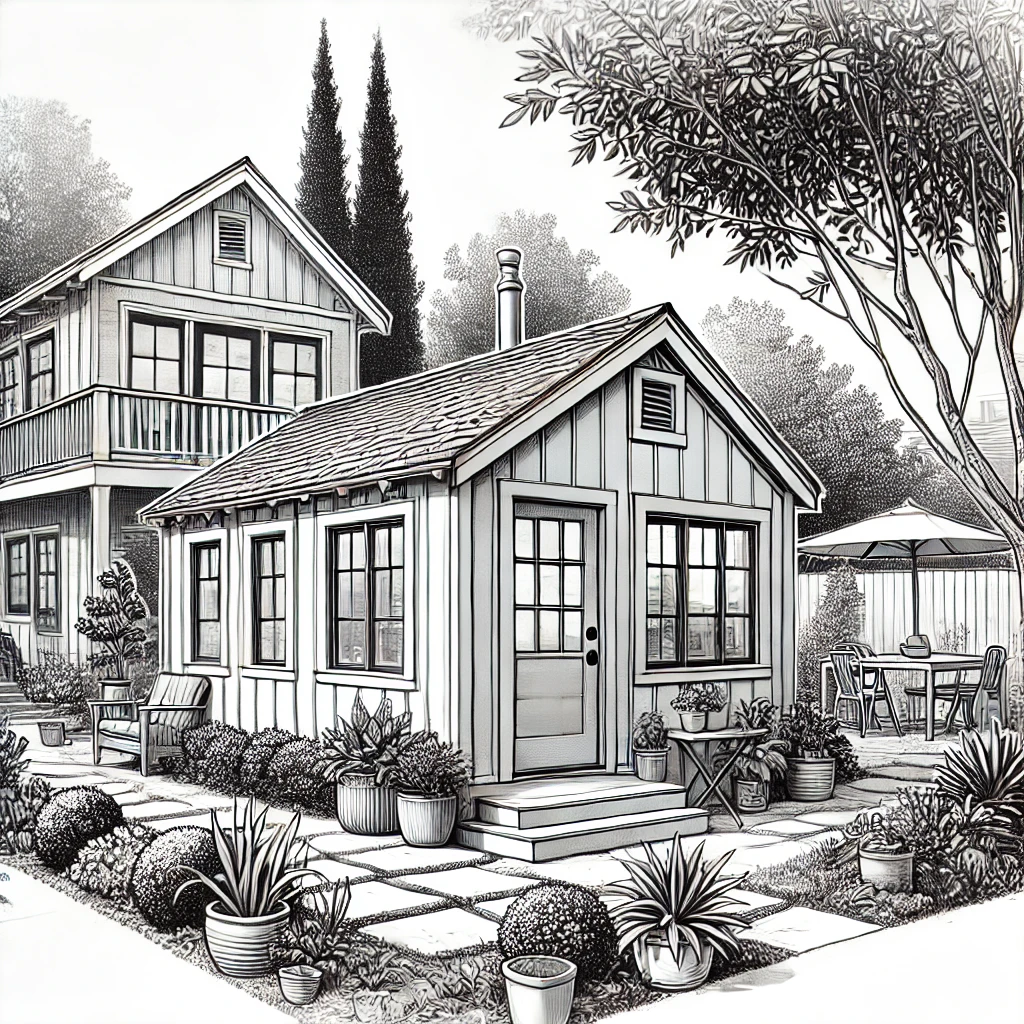Accessory Dwelling Units (ADUs) and Junior Accessory Dwelling Units (JADUs) are popular in places like California, and for good reason.
They help to provide extra housing or living space in quite a unique way, but they vary a lot in terms of size, construction, and regulations.
In this guide, we’ll compare the two to see which is better (if one is) and how they stack up against each other.
What is an ADU?
An Accessory Dwelling Unit (ADU) is a secondary housing unit situated on the same property as a primary residence.
These units can be standalone structures (also known as a DADU), garage conversions, or additions to the main house, and some studies have found that ADUs can increase property value by up to 35%.
ADUs typically range from 600 to 1,200 square feet and include all necessary amenities, such as a kitchen, bathroom, and living area. They provide a fully functional and independent living space, making them ideal for rental purposes, guest accommodation, or housing family members.
What is a JADU?
A Junior Accessory Dwelling Unit (JADU) is a more compact version of an ADU, generally created by converting existing space within the primary residence, such as a bedroom or a garage. JADUs are limited to a maximum of 500 square feet.
JADUs typically include a small kitchenette and share bathroom facilities with the main house. They provide a semi-independent living space suitable for short-term rentals, home offices, or housing family members who do not require a full suite of amenities.
5 Key Differences: JADU vs. ADU
Let’s take a look through the 5 major differences between ADUs and JADUs to see how they compare.
1. Size and Space Utilization
This is the most apparent difference between the two, as technically, a JADU is just a size variation on the traditional ADU.
ADUs
ADUs typically range from 600 to 1,200 square feet.
Due to this, they usually include full kitchens and bathrooms and offer complete living facilities. ADUs are suitable for creating independent rental units or guest houses.
JADUs
JADUs are limited to a maximum of 500 square feet and created by repurposing existing space within the primary residence.
They include a kitchenette and share bathroom facilities with the main house, making them ideal for smaller living spaces and home offices.
2. Construction and Cost
Construction as a whole and the costs involved are obviously higher for ADUs than they are for JADUs in most situations.
ADUs
ADUs can easily cost well over $100k to construct, depending on the features you want and the size you’re aiming for.
These costs cover the construction of a new standalone structure or extensive renovations.
JADUs
JADUs are much smaller than a typical ADU, so it shouldn’t come as a surprise that they cost less to construct – usually between $20k and $100k.
If you’re looking to make a smaller investment or work to a budget, a JADU is a more friendly option.
3. Regulatory Differences
The size difference also leads to a difference in regulations, making JADUs easier to build in most places.
ADUs
Subject to local zoning laws and building codes, which vary widely. These units generally require permits and must meet specific design and safety standards.
For instance, cities like Los Angeles and San Francisco have implemented regulations to streamline the ADU permitting process, encouraging more homeowners to build ADUs.
JADUs
JADUs often face fewer regulatory hurdles as they are considered part of the existing home. However, they must comply with certain local ordinances, including size restrictions and occupancy limits.
4. Utility Connections
Utlitlies are often overlooked, but it’s an important part of any construction and it differs between ADUs and JADUs.
ADUs
Separate utility connections for water, electricity, and sewage will be required, adding to the overall cost and complexity of the project.
This independence in utilities supports the ADU’s function as a stand-alone living space.
JADUs
Typically share utility connections with the main residence, simplifying installation and reducing costs.
This shared infrastructure makes JADUs less costly and easier to integrate into existing properties, but it does also hinder them as independent spaces.
5. Living Arrangements and Flexibility
ADUs and JADUs offer different living options and flexibility depending on how much space you need, and what you want to use the space for.
ADUs
ADUs work well as complete independent living spaces and can be suitable for long-term rentals, guest accommodations, or housing family members..
JADUs
Provide additional living space ideal for short-term rentals, home offices, or housing family members who do not require a fully independent unit.
Their smaller size and shared facilities make them less suitable for long-term independent living, although this can still be possible.
Financing Options for ADUs and JADUs
Financing the construction of ADUs and JADUs can be a significant consideration for homeowners. Various financing options are available to support these projects:
Home Equity Loans
Homeowners can use the equity in their existing property to finance the construction of an ADU or JADU.
Due to this, they’re usually lower interest than something like a personal loan
Private Lenders and Loans
Various private lenders offer loans specifically designed for the construction of ADUs and JADUs.
Which Is The Better Option?
ADUs provide larger, independent living spaces suitable for long-term rentals and family accommodations, while JADUs offer cost-effective, smaller-scale solutions ideal for short-term rentals and home offices.
One isn’t necessarily better than the other in general. It all comes down to your personal situation and what you’re looking to use the extra space for.
Working from home and need a killer office setup? A JADU would be the best bet.
Looking to provide living accommodation for a family member or close friend? An ADU would be more suited for this.
